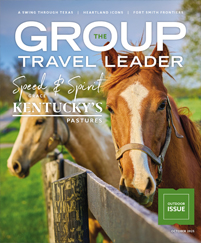Red or green? It’s a simple choice but an important one. Chile pepper sauce is at the heart of traditional New Mexican cooking, and the red or green sauce you choose will make a big difference in the heat and flavor of your meal.
When I visited Albuquerque and the surrounding areas in New Mexico last fall, I found myself making the red-or-green decision meal after meal. And this is only one of the choices in Albuquerque, where visitors have a wide range of options when they plan their tours.
There’s plenty of Southwestern sunshine to enjoy in the great outdoors, and there is the rich history of the Hispanic and Native American people who live in the area to experience. Today, Albuquerque is also known as one of the best places in the country for hot-air ballooning, and the city has a delicious culinary scene as well.
If you’re having trouble deciding which way to go, just do what I did: Try a little bit of everything.
Pride of the people
In the 16th century, when Spanish explorers arrived in what is now New Mexico, they encountered groups of native people who had lived in the desert for hundreds of years; they named the people “Pueblos,” which is Spanish for “villages.” Today, there are 19 Native American pueblos, or villages, in New Mexico, and Albuquerque’s Indian Pueblo Cultural Center gives visitors an overview of Pueblo art, history and culture.
The museum at the Indian Pueblo Cultural Center has exhibits on the languages of each pueblo and on the Pueblos’ first contact with European explorers. Artifacts on display include clothing, household tools and ceremonial items.
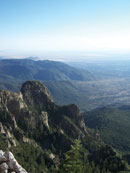 |
One of the highlights of the museum is its fine art section, which displays a wide range of pottery and other artwork created by the Pueblo people. A trip through the gallery allows visitors to see the interesting artistic touches and characteristics that distinguished the artwork of each pueblo.
Visitors can buy artwork, jewelry and other handmade items in the center’s 10,000-square-foot gift shop. The on-site restaurant has gas-powered “horno” ovens, which cooks use to prepare traditional Pueblo dishes.
Not far away, the National Hispanic Cultural Center traces the heritage of the Hispanic people, who have been an integral part of the Southwest since the Spanish arrived and began intermarrying with the natives.
“We’re the largest Hispanic or Latino center in the country,” said marketing and public relations director Danny Lopez as he showed me around the center. “We’ve put on over 600 programs. Last year, we had 200,000 people come through.”
The cultural center’s museum has a collection of some 2,500 pieces, historic and contemporary art produced by Hispanics in New Mexico. Hispanic heritage is displayed in the architecture of the building as well.
One of the most interesting aspects of the museum is a work in progress. Inside a 45-foot tower on the property, a local Hispanic artist is painting a 360-degree wall and ceiling mural depicting New Mexico’s Hispanic history. The painting will take several years to complete, but visitors can stop in to see the progress and talk to the painter. Once it’s finished, the work will be the largest concave fresco in the United States.
History outdoors
To look at artifacts in a museum is one thing, but visitors can see remnants of ancient civilizations carved into stone at Petroglyph National Monument. Between 1300 and 1650, the ancestors of the Pueblo people left more than 2,000 figures etched into rocks in a 17-square-mile area near Albuquerque that is now part of the national park system.
“To the Pueblo people, this is a sacred place,” chief of interpretation Diane Souder said as she led me around to some of the park’s most interesting sites. “We don’t really know what a lot of the images mean. But we do know that they were sacred images, and they continue to be impor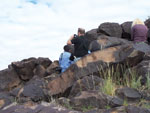 tant to the Pueblo people.”
tant to the Pueblo people.”
Souder explained that much of the rock in the park is black basalt, a remnant of ancient lava flows. The Pueblo people used stone tools to carve their images into the rock, likely as part of a spiritualistic ritual.
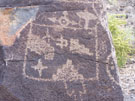 |
The park is also full of interest for archaeologists. There are about 350 archaeological sites at Petroglyph, including a 1,100-room adobe pueblo that has yet to be excavated.
I found more evidence of the past during a daylong excursion with New Mexico Jeep Tours, a company that takes visitors into the deserts outside of Albuquerque. The area is bordered by the Sandia Mountains and, like Petroglyph National Monument, was formed by volcanic activity.
The open wilderness offers plenty of desert beauty to appreciate and also a fair amount of history to explore. We visited a number of sites with ruins of indigenous and Mexican settlements, as well as animal fossils.
At one place we stopped, about 20 miles north of the city, the other travelers and I found numerous Indian artifacts, including painted pottery shards and three arrowheads. Our guide estimated that the items we found dated back to A.D. 600″“1200. We held the objects in our own hands and then put them back where we found them for the next group of adventurers to discover.
Up, up and away
Today, Albuquerque is known for its annual International Balloon Fiesta, which draws 700 or more hot-air balloons each October, along with more than 700,000 spectators. The area’s climate is near perfect for ballooning, which means that visitors can take to the skies at any time of year.
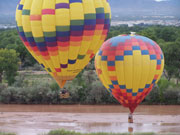 |
I went up with some other visitors on a flight with Rainbow Ryders Hot Air Balloon Co. and pilot Randy Johnson early one morning. Our flight took us out over the dramatic New Mexico landscape and the Rio Grande, which runs from Colorado to the Gulf of Mexico.
As we floated, Johnson told us about the physics of hot-air-balloon flight and the natural features of Albuquerque.
“The wind is going in different directions at different altitudes, so if you change your altitude, you change your direction,” he said. “The reason why ballooning is so popular here is that we have more air thermals and more open space than anywhere else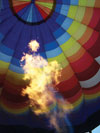 in the world.”
in the world.”
After landing, I visited the nearby Anderson-Abruzzo Albuquerque International Balloon Museum, which has hundreds of exhibits and artifacts celebrating the sport of ballooning. Displays cover a range of subjects, from the evolution of balloon fabrics to different ways the military has used balloons since the Civil War.
Highlights of the collection include the first manned balloon to cross the Pacific Ocean and a hyperbaric chamber used by late balloon pioneer Steven Fosset to acclimate himself to low air pressure. A simulator at the museum lets visitors try their hand at launching, steering and landing a hot-air balloon.
Tasting the Southwest
I’ve always thought that one of the best ways to get to know a place is to taste it, and Albuquerque is full of flavor. From traditional New Mexican restaurants to bakeries and even a cooking school, I had my fill of great food in Albuquerque.
At Blue Plate Special, a local catering company, groups can take cooking classes with owners Scott and Gwen Clapp, who have been teaching Southwestern cuisine since 2001. I joined one of their hands-on classes, where we prepared chile rellenos, stacked enchiladas and other traditional New Mexican dishes.
As we cooked, Scott told us about the history of the food we were preparing and about how that spicy capsaicin in food affects the tongue.
“Capsaicin is addictive, and as you eat it, you build up a tolerance to it,” he said. “So asking a New Mexican person if something is spicy isn’t likely to be very helpful.”
I also visited Golden Crown Bakery, a family-owned business where workers prepare a number of New Mexican specialties, including a green chile bread with peppers, cilantro, onions, cheese and other ingredients baked right in.
Golden Crown is also famous for its “biscochitos,” small Mexican-style shortbread cookies sprinkled with sugar and cinnamon that are hallmarks of New Mexico. During the Christmas season, the bakery makes 12,000 of the cookies each day.
Owner Pratt Morales shared his chief culinary secret with me.
“Our food is nutritious, delicious and beautiful,” he said. “It has to be beautiful. If it doesn’t look beautiful to your eyes, you’re not going to eat it.”
Biscochitos are a beautiful end to any meal, and a great way to cap off a tasting tour of all of New Mexico’s flavors.







